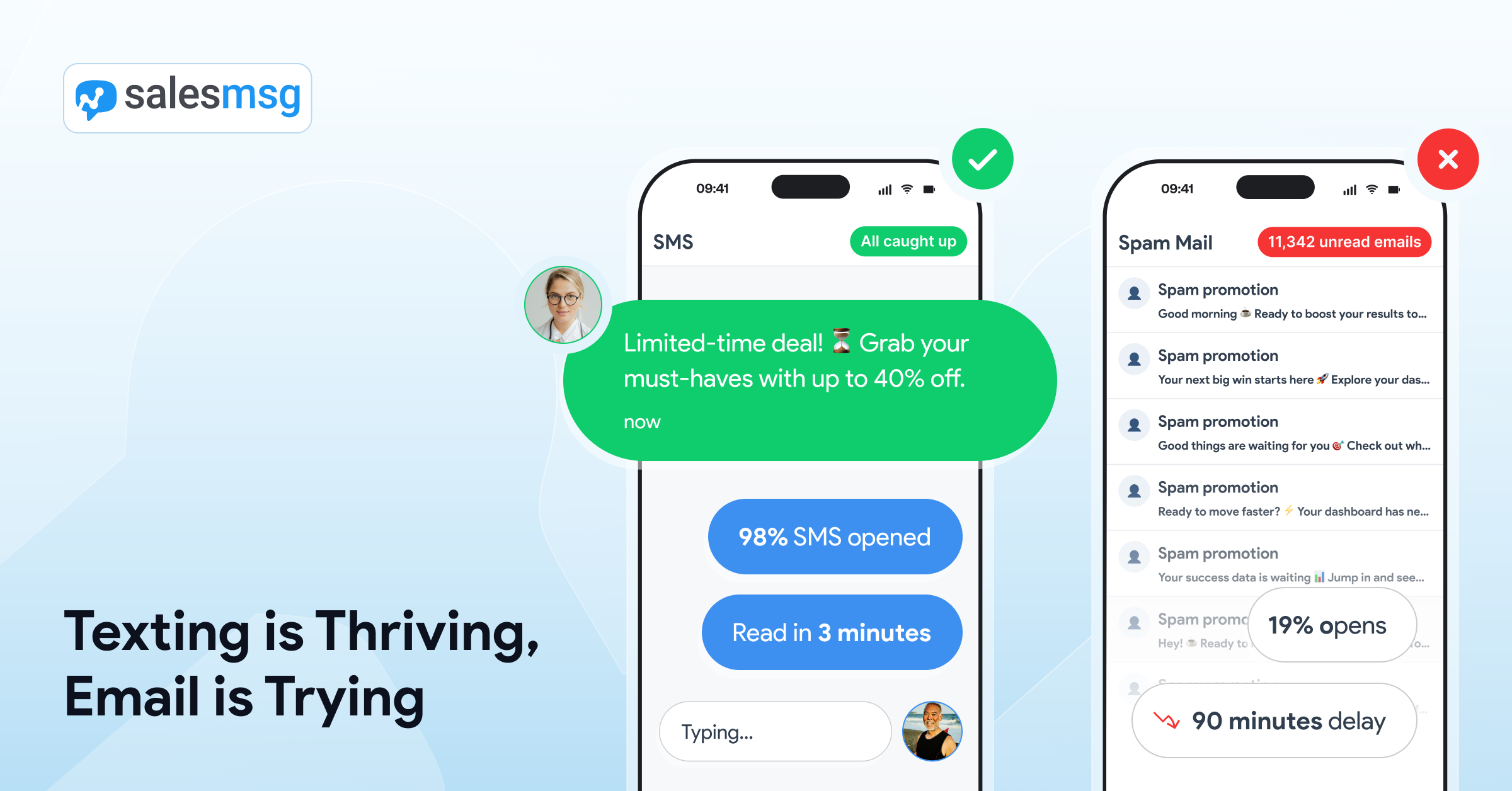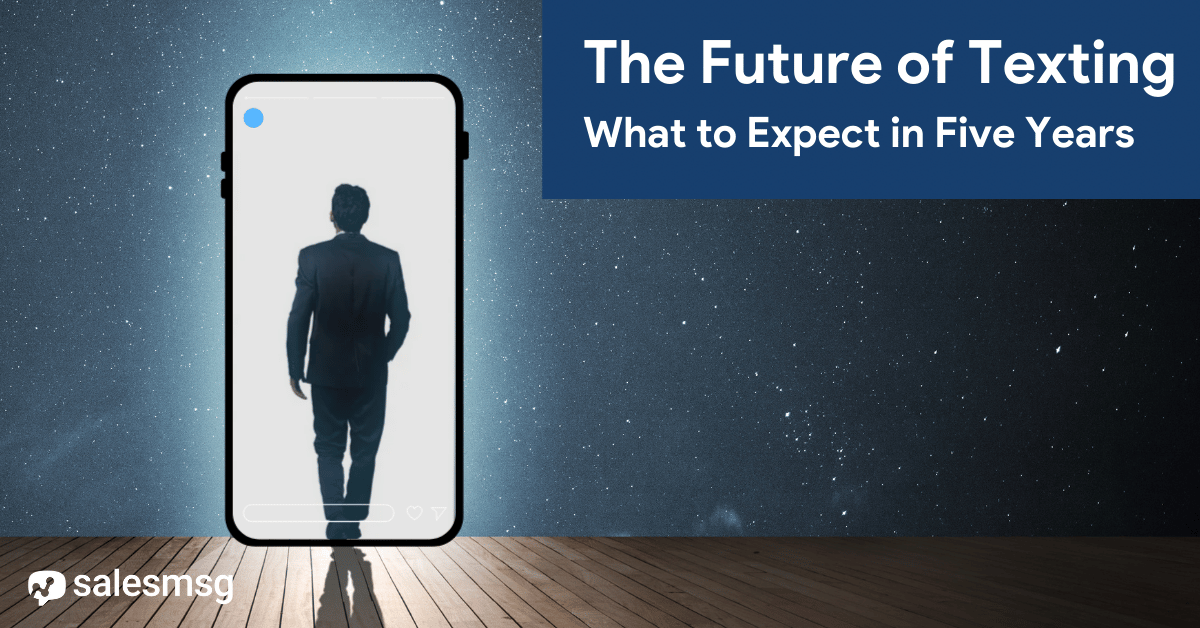How to Avoid Random Acts of Marketing: Just Text'm

Marketing should feel creative. But, a lot of marketing feels like throwing paint at the wall, hoping some of it sticks.
Sure, there’s a lot that goes into every single marketing campaign. But, it shouldn’t feel random. Instead, every moving piece should play together, just like an orchestra with dozens of different musicians, all in sync.
If your marketing feels stuck, or there’s a point in your growth trajectory you just can’t hurdle, then it could be random acts of marketing rearing its ugly head.
Luckily, there’s another reality that awaits you. One where every single marketing action supports your business growth. One where your actions across every platform and medium bring you closer to your KPIs. One that's actually simpler, while bringing faster and better results.
In this article, we’ll show you how you can align and integrate your sms marketing campaigns, so no single campaign operates in a vacuum. You’ll learn how you can elevate your marketing to a more strategic level, while bringing that strategy to life with the power of HubSpot and Salesmsg working together.
Marketing Agility vs Random Acts of Marketing: Where’s Your Business?
Before we dive deeper into the practicalities of managing integrated and aligned marketing campaigns, let’s go into the alternative a bit.
See, there’s a big difference between agility and random acts of marketing. But, they can feel the same, since you’re operating so quickly. But, one supports your sales and marketing efforts, while the other can have you sprinting in the wrong direction. By the time you finish the race, you realize you’ve been running full speed down the wrong track.
Random acts of marketing might feel like you’re moving closer to your goal, but there’s really no way to tell. It happens when growing businesses market reactively, trying dozens of different campaign ideas, focused on experimentation above all else. But, instead of moving closer to your goal, you burn through revenue, don’t establish brand value, or deliver any measurable results. I am sure you've heard it before... "let's see what sticks!"
Compare this to agile marketing methods. Even though you’re moving quickly, there’s an underlying strategy that powers every marketing action.
Your campaigns will be strategic since you know the exact prospects you’re targeting, and why. You know the types of problems you’re solving for your leads. And you know why your customers are choosing you over your competitors.
Overall, speed is still important. But, it isn’t just executing for the sake of taking action. It’s taking actions that are aligned with an overarching strategy and aligned with your business objectives.
Let’s say you’re at a track meet, or simply watching a meet. There are dozens of different events, sprinting, long-distance, shot put, high jump, and pole vaulting. Each athlete you see has a very specialized set of skills. The fastest sprinter will be the slowest long-distance runner. Your top 2-mile athlete would come in dead last at the high jump.
Compare this to your business. Are you competing in the wrong event? Are you trying to market to everyone and everyone?
Are you watching another event, thinking it looks easy, and trying to compete? Or, are you staying in your own lane? Seeking to dominate, before you expand into other markets.
Once you determine where you stand, you can begin to execute in a more strategic way. Tactics are fun and the implementation of tactics is what moves the needle. But, surviving on tactics alone won’t help your business compete in the long-run.
Start one level higher, then see which strategies and tactics most align with your business goals.
Which brings us to our next step…
Understanding Customer Behavior and the “Problem” of Anonymous Leads
Before we get into the nitty-gritty details of setting up campaigns, we need to discuss “how” you’re going to reach modern buyers.
In an ideal world, a buyer will see your content, sign up for a free resource, consume a bit more content, then hop on a sales call, and the deal is closed. However, reality operates a bit differently. According to research from LinkedIn, only 25% of buyers are willing to share their contact details to access content.
This shift is due to the nature of tech buying. Rarely, will you be dealing with a single person. Instead, it’s more of a company-wide endeavor and it’s hard to know who you’re actually dealing with. But, just because they have a desire to stay anonymous doesn’t mean that aren’t checking out options and testing out solutions.
That’s why when you’re mapping out your campaign strategy, you should start treating your anonymous buyers as anonymous customers. Think of it like earning the right for your customer to share their contact details.
There are a lot of ways you can go about this, from creating in-depth educational content, and offering high-quality freemium products, to hosting webinars without the hard pitch at the end. Essentially, offering a ton of free value up-front, all without expectation.
And, if there’s one channel that’s the lowest commitment, and easiest to deliver value? It’s texting.
Think about it.
All they need to provide is a phone number. It can even be a business number and not their personal line. Then, you can start sending messages with free resources, seeing how you can make their experience better, and what they’re looking for in a solution. It's not only the fastest, but also the easiest, way to bring new leads further into your world.
Plus, when you share valuable resources there’s a chance this gets passed on to other team members who may be part of the purchasing decision down the road. A few simple text messages to influence the buying decision of an entire team? Sign me up.
How HubSpot Campaigns and Campaign Templates Create Repeatable Marketing Growth
So far we’ve been pretty theoretical. Now, let’s get into how this breaks down on a practical level. Before you start creating campaigns you need to have the following in place:
- A deep understanding of your target market, including buyer personas, and customer profiles
- A plan for the marketing channels you’re going to utilize (text, email, social, ads, etc…)
- An idea for the types of marketing content you’ll need for each channel
- The key metrics you’re going to measure that’ll show you campaign success or “needs improvement”
Did you check all those boxes? Great! Now, we can take that high-level understanding and get to work.
HubSpot has all kinds of useful tools to support your marketing and sales teams. As a whole, it truly helps your teams stay on the same page while seeing the success of your marketing campaigns.
But, what are HubSpot campaigns? And how can they help you “organize” your marketing efforts?
Essentially, HubSpot campaigns are a group of marketing assets and content within a certain marketing campaign. Having all of these assets together helps you manage the effectiveness of your campaign as a whole. Campaigns give you everything you need to build, manage, and collaborate from one place.
Campaigns help to focus your marketing efforts, ensuring you’re communicating with an aligned voice, guiding your customer along their journey, while reducing friction, helping you meet goals, and delivering results.
Now, with a new HubSpot feature, we can take this even further with HubSpot campaign templates.
Imagine a future where you have a new marketing initiative you want to run. Instead of building everything from scratch, you just pick a high-converting template you used in the past, then plug in the details.
This ensures that your entire team is on the same page and you’re able to replicate the results while executing quickly.
Most marketing teams haven’t realized the power of using HubSpot campaign templates yet, so you’ll be at an advantage here.
Campaign templates let you choose from high-converting playbooks to more quickly achieve your marketing goals. Or, if you have existing campaigns that have been successful, you can create a template out of that to help replicate the results in the future.
Essentially, campaigns give you a documented set of steps to create repeatable marketing campaigns.
You can set campaign goals, choose your audience type, budget, campaign dates, and more. Then, you can use the drag and drop builder to create the sequence of how you’re going to market. For example, will you start with an email announcement, then a social media post? Or, start with a text, see the response, then move onto other channels?
For every step, you can also add a content asset that’ll be associated with it too. If you’re running similar campaigns throughout the year, this can be a huge timesaver.

Integrating SMS Marketing Into Your HubSpot Campaigns: 3 Levels
Excited yet? Well, you can take your results using HubSpot campaign templates even further using our Salesmsg integration. With Salesmsg you can integrate business texting into every step of your marketing campaigns.
Making your execution simpler and much more effective.
For example, launching a new webinar? Beyond sending a series of emails, you can send SMS messages, before, during, and after your event to improve sign-ups, conversions, and user experience.
SMS enhances every step of your marketing. It gets high engagement and even higher conversions. Plus, it’s the most personal marketing channel and helps you build strong bonds with your customers.
Here are three different marketing campaign types and how Salesmsg and HubSpot working together can bring them to life.
Tier 1: Omnichannel Campaigns
First, we have true omnichannel campaigns. Hit your prospects with the entire kitchen sink. It’s delivering a marketing experience across all channels, platforms, and devices.
Omnichannel gives you ultimate reach. You can reach your customers where they are. No matter what device or channel they’re using, you’re just a click away. Plus, these marketing channels are all unified, so your users always get the same experience.
Here’s an example of how this works:
Let’s say a customer is browsing your website, but they decide to leave. Instead of being gone forever, they’re automatically retargeted with ads on Facebook, Instagram, and LinkedIn. Then, they’ll also receive an email and SMS message.
The key to making this an omnichannel experience is making sure your brand voice and messaging is the same.
You can integrate this into any existing sales funnel to help reduce customer drop-off. SMS messaging is super effective at this since it’s so easy to bring a prospect back in. All it takes is a simple text message to discover why they dropped off in the first place. Then, you can begin re-engaging them to see if they’re a warm lead worth passing on to your sales team.
Now, there’s a lot of moving pieces in these campaigns. You have ad creative, email copy, SMS messages, social media posts, and maybe even an announcement blog post.
HubSpot campaigns help to keep all of this in one place, and make your life easier.
Here’s what an omnichannel campaign could look like using a HubSpot campaign template:
Tied 2: Multichannel Campaigns
Next, we have multichannel campaigns. Here, you’ll be using a few channels to reach your prospects. The most common example here is using email and text to achieve a single marketing objective.
For example, you could be trying to generate more sign-ups for an upcoming webinar, so you reach out to prospects via text and email. With multichannel you create tailored messages for each channel and will be tracking the performance of each individually.
This can help you see which channel is the most effective in reaching your prospects and has the best conversions. For most businesses, we've seen SMS outperform time and time again. Will your business be next?
If you’re using HubSpot, then you can see all of your campaign data in one place, including your SMS campaign data.
Tier 1: Single-channel Campaigns
Finally, we have single-channel campaigns. This is when you market to customers using only one channel.
One common example is sending out an email blast to drive traffic to a new blog post, or test the conversions on a landing page for a new offer.
Usually, when you’re using business texting it’ll be in the support of other campaigns. But, it can also be used on its own. For example, it can be used in lead gen to help grow your customer base without a huge marketing spend.
One way to do this is to create a text-to-win contest or a giveaway. Then, create a textable phone number for users to enter the contest. All they need to do is text the number, then they’ll get a response like the one below.
This can be a quick way to grow your SMS list. Plus, you’ll get new users to sign up, without doing any additional work. A study found that 45.7% of people will share your contest, even if there’s no incentive offered.
Plus, any new lead data you collect via text will automatically be sent to your HubSpot contacts.
Single-channel campaigns can also be a great way to validate marketing ideas before you bring every channel together or invest more time and resources into a new campaign.
For example, let’s say there’s a new upsell package you want to create, but you want to test it with your audience first. All you need to do is send out a quick SMS message to gauge interest and maybe even get a few sign-ups.
Here’s a sample message:
“Hey, (name) we have a few spots open for (potential offer), interested?”
In general, single-channel campaigns are more targeted and used when your prospect has already shown their preferred communication channel. So, they’ll be much further down your pipeline, and you’ll have much more customer data to work with.

Align Your Marketing, Delight Customers, and Hit Marketing Goals with HubSpot and Salesmsg
Imagine a future where your marketing campaigns resonate deeply with your prospects, deliver results aligned with your greater business goals, and (best of all) are repeatable.
Your marketing has grown from simply throwing paint at the wall, to a beautiful Jackson Pollock hanging in the MOMA.
With the power of HubSpot campaign templates and our Salesmsg integration, you can create high-converting marketing campaigns again and again. Say goodbye to random marketing campaigns or one-off marketing efforts that don’t move the needle toward business growth.
HubSpot and Salesmsg make it easy to create marketing campaigns that reach your customers, no matter where they happen to be.





















